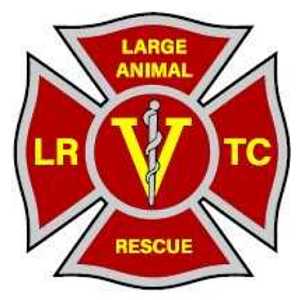|
A neonatal foal emergency is often a critical emergency. If a foal that is only a few hours old cannot stand and nurse, or if the dam dies, is driven away or is otherwise unable to care for the foal, chances of survival will start to decline after a couple of hours. Accurate objective assessment of downed or isolated foals can be critical to determining appropriate field "first aid" actions and destination decisions if the foal cannot be successfully reunited with its dam. This Information Sheet addresses recommended practices involving downed or isolated neonatal foals that upon investigation cannot be supported by a viable dam.
Recommended actions for older foals include efforts to identify and locate the foal's dam, and if possible, reunite the pair. However with neonates, the window of viability closes rapidly. While attempts to locate a dam should be made, such efforts should not delay immediate care and appropriate treatment of a neonate.
- Foals that have integrated into the wrong band will sometimes reunite with their dams. Monitoring to determine whether or not the foal and dam can reunite should be undertaken and circumstances documented before requesting authorization to intervene.
- Foals whose dams are deceased or foals that have not reunited with their dams need to be assessed before requesting authorization to intervene. Are they socially integrated with the band (accepted and protected by the band?) Are they old enough to get sufficient nutrition by grazing? If very young, is another mare in the band allowing them to nurse? Remember that it is often more dangerous to a foal to remove it than to leave it alone and monitor, provided it is socially integrated and is getting a reasonable amount of nourishment.
The dam of the foal on the left was struck and killed in a highway accident. He is being nursed
by an "auntie" and is socially attached to his half-brother. It is often better to let foals stay in a
socially supportive group and not experience the stress to their immune systems that result from being
transplanted into a foreign environment. This is why any removals must be medically justified.

2. INITIAL CONCERNS / ACTIONS
Two primary concerns involve environmental stress (typically hypothermia) and the foal not receiving colostrum shortly after foaling.
Foals have little subcutaneous fat, a high ratio of surface area to body mass and minimal
energy reserves. Therefore hypothermia can be a significant concern as well as exposure to excessive heat. A normal body temperature range is 99o to 101.5o F.
Neonates that appear to have not received colostrum are at great risk. Their abilities to absorb antibodies decrease to about 22% after three hours and decline to less than 1% after 20 hours. (A delay in nursing does not appear to delay the closure of the neonatal gut.) They have to receive colostrum before taking in other liquids as their gut permeation for absorbing colostrum antibodies may "close" when they start to absorb other liquids such as water or milk. Do not provide liquids other than colostrum to a neonatal foal without first discussing the details of the incident with a qualified veterinarian.
Another concern involves infection. The umbilicus should be dipped in .05% chlorohexidine solution to reduce the risks of bacterial infection.
"Feathers" on this foal's hooves reveal that it is neonatal (newborn) and special considerations apply.

Neonatal foals require special handling. Typically it takes a few days for their abdominal muscles to gain tone. Simply picking them up by hand can result in organ damage. They should be moved by rolling them onto a blanket for a blanket carry, onto a Foal Glide or onto a Foal Carry-all.
This neonatal foal, found alone alongside a highway, is being properly moved for transport.

3. FIELD BEST PRACTICES
For non-neonatal foals, administration of small quantities of water and electrolytes may be appropriate.
Critical key point: Administration of electrolytes to a dehydrated horse can actually increase dehydration and produce salt toxicity. Field administration of liquids must be provided sensibly and in moderation, with electrolytes (if appropriate) provided in comparatively minor quantities and in accordance with label directions.
An abandoned foal may appear lackluster and suffer from hypoglycemia. As it is not practical to test for blood sugar levels in the field, administration of a dab of molasses or Karo Syrup to a foal's gums may be considered, but the quantity applied should be minor. "Foal Response" (from a tube) may be appropriate if the foal has a viable swallowing reflex. If in doubt, try to get advice from a veterinarian and prepare to transport the foal upon authorization.
Most range foals are federal, state or tribal property, depending on their location. Authorization protocols must be followed before removing them from the range. If there are exigent circumstances where a foal has to be immediately removed, such as a foal found on the roadside following an accident, the agency having legal ownership must be formally notified.
When reporting a downed or abandoned foal, provide a complete description as well as the location found (use your phone's GPS feature in areas away from roads or landmarks) and a description of the band that the foal was associated with, if applicable. Complete, accurate documentation is critical for herd management purposes and to identify any trends that could be impacting the horses and foals.
When a "shelter in place" decision is made based on criteria that a particular foal is better off left on the range rather than experiencing the stress of being removed, follow-up monitoring should be initiated. Persons involved with follow-up monitoring should do so from a distance using binoculars and not stress the band. Volunteers must also be respectful of private property and not trespass.
4. RESPIRATORY ISSUES
Neonatal foals should present with respiratory rates of 60-80 breaths/min for foals less than 2 hours
old, and 20-40 breaths/min for foals over 2 hours old. For foals presenting with depressed or labored respirations, the mouth should be cleared of mucous and any foreign objects, and the foal may be provided supplemental oxygen.
For marginally inadequate respirations, "blow by" oxygen can be provided using a small Air for Paws mask with oxygen flowing at 8-10 L/minute. Ventilation may be required if the foal's breathing is significantly depressed or compromised. Ventilation should be provided via a small Air for Paws mask and small AmbuBag. If adequate spontaneous respirations resume, ventilations should cease and "blow by" oxygen be provided. Note: Almost 90% of foals requiring resuscitation respond to ventilation alone and require no additional therapy.
Respiratory support and ventilation can consume significant amounts of oxygen. Spare cylinders must be available.

5. TREATING INJURIES
Foals can become injured due to environmental hazards, human hazards, dog attacks (most common) and occasionally from predator attacks. Animal attacks in particular can produce infections that could ultimately prove fatal. Most foals can be treated in the field by capturing the foal, cleaning wounds, administering antibiotics and returning it to their bands.
In some instances definitive care by a veterinarian is warranted. When practical, a foal should be brought in with its dam, treated professionally, handled to the greatest minimal extent, and the pair returned to its original family band once the foal is cleared by the veterinarian for release.
When it is not practical to bring in both the mare and foal and the foal is not cleared for release in less than approximately 24 hours, the foal will then need to be placed in the care and custody of a competent rescue group and eventually placed with an adopter. An exception could be an older foal of weanling age that could reintegrate with its band and flourish if its dam'smilk has dried up.
Some foals can be treated in the field, released and monitored.
Care must be taken to ensure that the other horses don't react to the treatment.

6. TRANSPORT ISSUES
|
Most range foals are federal, state or tribal property, depending on their location. Authorization protocols must be followed before removing them from the range.
Time is of the essence. Obtain authorization to transport to the closest appropriate facility and initiate transport as soon as the foal is stabilized.
NEVER pick up and carry a neonatal foal. Use an appropriate carrying appliance (blanket, tarp, Foal Glide, Foal Catty-All, etc.)
When possible, transport with the foal in a sternal position to facilitate more effective respirations and to minimize the risks of
aspiration if colostrum or Immunoglobulin G is provided enroute.
|
|

|
Foals can respond remarkably well if provided proper field treatment and appropriate veterinary care.


The training information presented in these information sheets and guides is offered for illustrative and volunteer refresher purposes only. It is not a substitute for actual hands-on training.
|
Press Back to return to the page which brought you here
| 










